More seal pups arriving at seal rescue centres in Lincolnshire than ever
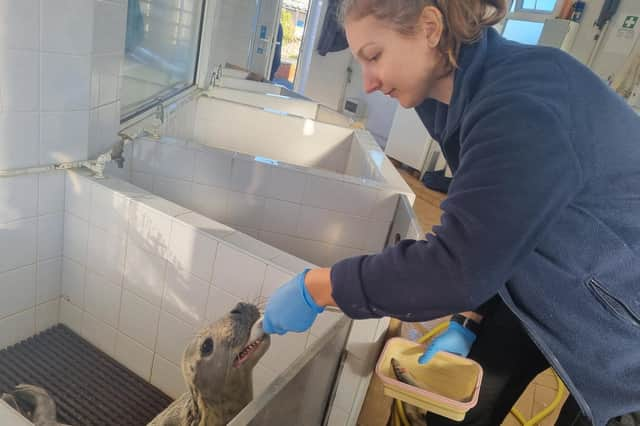

He was safely wrapped in sacking to keep him still while Skegness Natureland director Daisy Yeadon administered his treatment.
"The wound probably happened at feeding time - it happens," said Daisy, carefully cleansing the area to prevent infection.
Advertisement
Hide AdAdvertisement
Hide AdToday is a good day as two Harbour seals - named Wagamamas and KFC as this season's theme for rescues is cafes and restaurants - are on a trailer ready to be taken to the beach and returned to the sea.
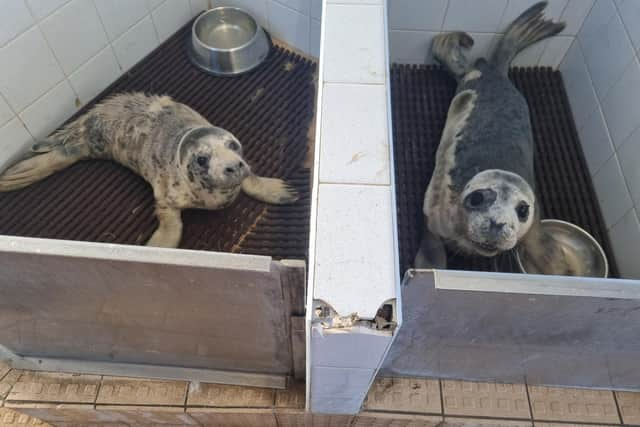

Their big bright eyes peer through the crates unaware of the adventure they are about to embark on.
Each weighing more than 30kg, it is a challenging push up the ramp from the Sea View Road car park which leads to the beach.
However, the tide has left the sand firm and the trolley runs smoothly across last few yards close to the waters edge.
Advertisement
Hide AdAdvertisement
Hide Ad"It's always a bitter sweet day for the keepers when they return to the sea," admitted Daisy. "We are always pleased when they are well enough to go back but they are all different characters and while they are with us we get fond of them."
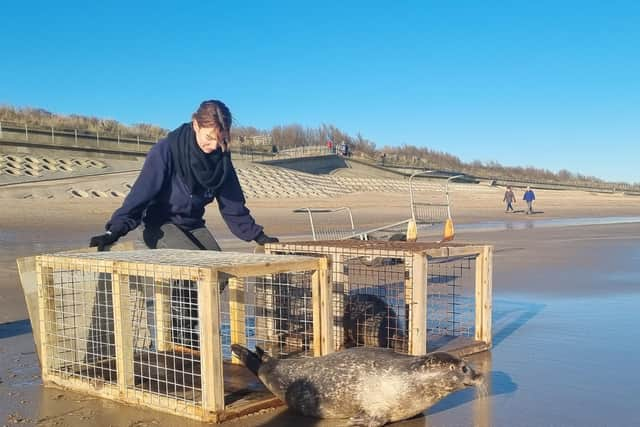

Pups can be in rescue for months.
"The first problem is persuading the pup to eat," said Daisy.
"The pup suckles differently from other animals and they cannot be taught to suck from a bottle.
"With a little help for a week or two they can swallow a few whole fish, mainly sprats, which are about three inches long.
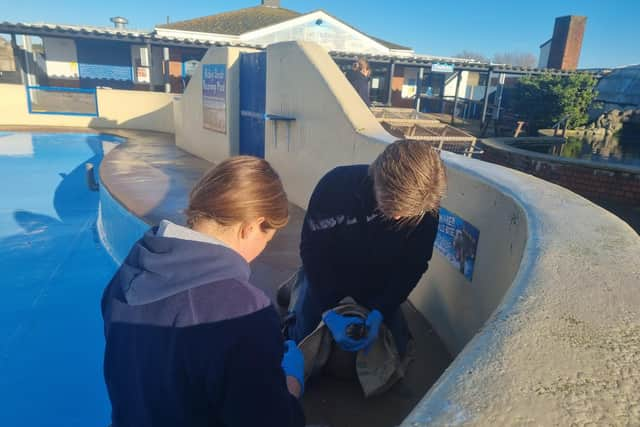

Advertisement
Hide AdAdvertisement
Hide Ad"At first their mouths must be manually opened but they soon get the idea and queue up for their two hourly feeds.
"To help keep them healthy we give them vitamins and other medicines – just slipping each pill inside a small fish.
"If all goes well the pups are moved into the rearing pool where they are taught to feed on fish in the water and gain the body weight they need to survive in the wild.
"Some months after joining us - when the pup is fit, fat and healthy - it is returned home to the sea."
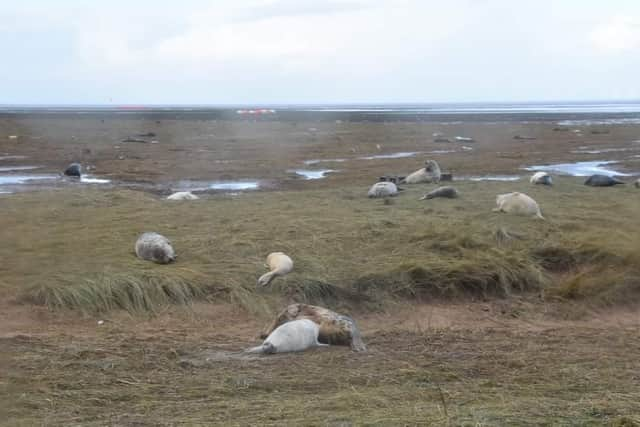

Advertisement
Hide AdAdvertisement
Hide AdYour Lincolnshire World reporter has attended a number of releases over the years - and often the seal pups need a little encouragement to leave the safety of the crates and the keepers who have cared for them.
However, on this occasion the seals needed no encouragement. As the sunlight glistened on the calm spring sea, they headed out immediately, staying together and appearing to dance in the waves before heading north and out of sight.
2022 has been a particularly busy season for seal rescue centres along the Lincolnshire east coast.
One of the biggest grey seal colonies in the UK is at Donna Nook. One hundred years ago grey seals were down to a few hundred animals.
Advertisement
Hide AdAdvertisement
Hide AdNow there are over 200,000 and half the world’s population live around our shores.
More than 2000 pups were born during the breeding season at the popular Lincolnshire Wildlife Trust location. The first was born on October 28 last year with just 19 recorded in the viewing area at the beginning of January 2022.
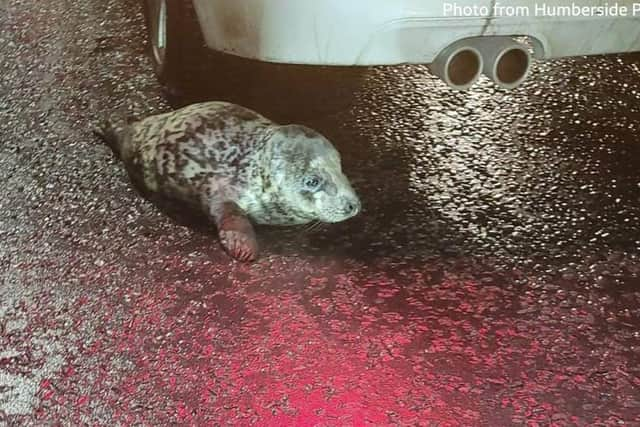

Many orphans are now finding their way into the coast's main rescue centres - Mablethorpe Seal Sanctuary and Wildlife Centre and Skegness Natureland.
Seal pups which find themselves in the sanctuaries are usually diseased, often with lungworm, and arrive exhausted and dehydrated.
Advertisement
Hide AdAdvertisement
Hide AdMablethorpe Seal Sanctuary, which is closed to the public until February half term, currently is caring for around 13 seal pups, including 10 greys.
One of the latest rescues to arrive is called Oreo and became a television celebrity after being found by police in Grimsby town centre and reported to Cleethorpes Wildlife Centre.
Over 1,000 seals have been treated at the sanctuary since it opened in1974 - and, as you may have guessed from Oreo, this season's theme for naming them is 'biscuits'.
The hospital and new seal recuperation building have a variety of pools that allow keepers to provide a seal with intensive care at first but then move it on to bigger pools and more competition as they get stronger.
Advertisement
Hide AdAdvertisement
Hide AdTo get their share of fish they quickly learn to become faster in the water and are able to build up their muscles. This is essential training if they are to be fit enough for a life in the wild.
Keepers try and provide a range of foods including flat fish, which are the most important food for grey seals on the Lincolnshire coast, herring, sand eels, mackerel and sprats.
Chloe Drew, director at Mablethorpe, said: "We have been much busier than last year. We have 50 different species of animals in the rescue centre but caring for seals has always ben an important part pf our work.
"The seal hospital was built in 1989 but rescuing seals has always been a major part of what we do.
Advertisement
Hide AdAdvertisement
Hide Ad"Our main aim is to return our rescues into the wild - that is where they belong."
Since the beginning of this breeding season, Skegness Naturland has cared for 41 seal pups and currently has five Harbour seals in its outside rearing pool and 10 greys in the hospital.
Fortunately injuries caused by fishing netting are not discovered so often as a few years ago.
"We haven't had any entanglements for a couple of years, which is good," said Daisy.
Advertisement
Hide AdAdvertisement
Hide AdBoth Mablethorpe and Skegness sanctuaries are charities, relying purely on donations and visitors to survive.
A year ago it was a particularly worrying time for Skegness Natureland, with the Covid-19 lockdown and restrictions impacting the number of visitors and income from the public.
Special fundraisers and appeals were launched to help with the cost of food and care and the future of the family-run centre in Skegness that has been loved by generations was uncertain.
However, this year the outlook is much brighter.
"Once restrictions were lifted last summer we had a bumper season, with more visitors than in the past 15 years, so this year we are in a much better position," said Daisy Yeadon.
Advertisement
Hide AdAdvertisement
Hide AdIt is expected the rescue season will carry on until at least May. Both Mablethorpe Seal Sanctuary and Wildlife Centre and Skegness Natureland welcome donations to help them continue with their work. Details on how to do this can be found by visiting https://www.thesealsanctuary.co.uk/ and https://www.skegnessnatureland.co.uk/